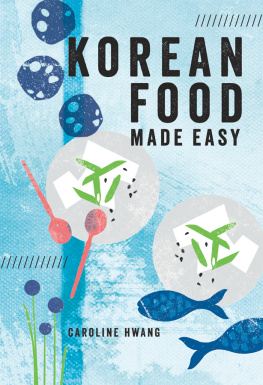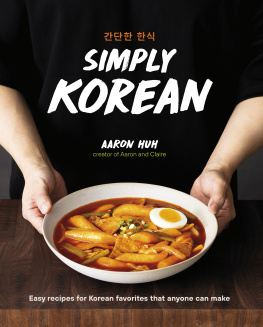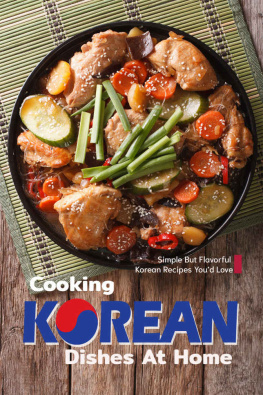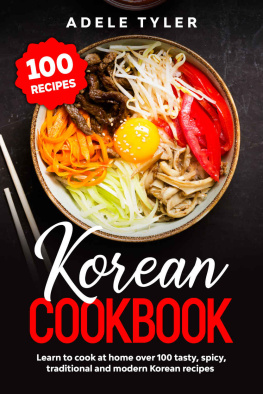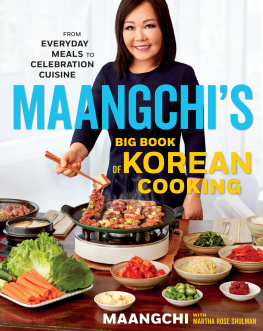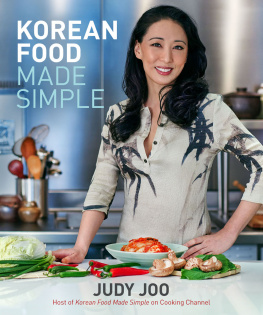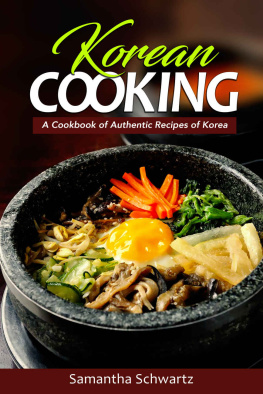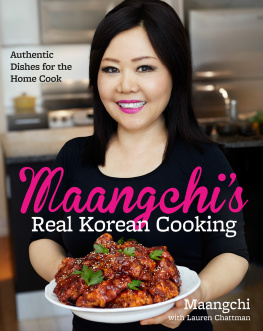Korean cuisine is one of the simplest, healthiest and friendliest in the world its dishes are perfect for sharing. Its fun to cook Korean: with just a few easily sourced ingredients youll be able to create your first banchan, the small but delicious side dishes that are served at every meal, and the amazingly simple gut-affirming kimchi, which works with just about any vegetable. Soon youll graduate to the ever-popular Korean barbecue recipes, sushi, noodles, one-pot stews and dosirak the perfect packed lunch. Koreans often start a meal with the joyful phrase Please, eat well! because they know that food is best eaten in good company and that good health begins with a happy gut.
Korean Food
At the beginning of every meal, Koreans often serve it saying, Please, eat well! Health is of the utmost importance to Koreans, and eating well goes hand in hand with that as health begins at the gut. Eating is also a communal experience banchan, the small side dishes that are served at every meal are meant to be shared as are most of the mains that are served.
The dishes are meant to be eaten all together, with no serving utensils, just personal chopsticks and spoons dipping into the communal pot. This is the moment in the day, if nothing else is said, where something is shared with those you eat with. To many people, Korean food seems complicated and probably very difficult, but it is one of the easiest cuisines to cook. It is a cuisine that requires essential ingredients to get started, but once the pantry and fridge has been filled, you should be ready to go. korean food made easy is filled with recipes for all the staple banchan you love TO EAT at your favourite Korean restaurant. This book also has recipes for shop-bought treats likes melon ICE LOLLIES or mochi filled with red bean, but without the MSG or additives you would normally find in them if you bought them at the shop.
For some dishes, all it takes is a little marinading and grilling, such as the ever so popular Korean barbecue dishes like that will be the envy of all your co-workers. youll find yourself confident enough to have a little party to share your new culinary discoveries after just cooking a few of these wonderful recipes A party where friends and family can commune at a table and share a story over a hot pot of stew or fight over the last fried chicken wing. korean food made easy will leave you feeling nourished and ending your meal saying what Koreans always say when theyre done with a meal: Thank you so much. I have eaten very well.
TOP 12 STAR Experiences of Korea
1. 2. 2.
Namdaemun Market in Seoul One of the busiest street markets in Korea, bustling with street food from Ddukbukki to fried chicken. Find the best doenjang, gochujang and other Korean ingredients here as well. 3. DMZ The Demilitarized Zone at the border of North and South Korea. 4. 5. 5.
Sokcho Try soondae , Koreas black pudding (blood sausage) in this beach village, heavily populated with North Korean refugees. 6. Chungcheong-do Enjoy a temple stay at Beopjusa Temple and sleep in renovated hanoks. See the largest standing golden Buddha in Korea. 7. 8. 8.
Wonju Experience James Turrells Colourful Night at Museum San, a beautiful museum built within its natural setting by Tadao Ando. 9. Namsan in Seoul Take a romantic hike up Namsan and place a love lock on the North Seoul Tower. 10. Han River in Seoul Ride bikes and then picnic by ordering fried chicken and beer to be delivered! 11. 12. 12.
Seoraksan Spend a day in the clouds and visit the hot springs of these rocky mountains.
Fresh Ingredients
1. Garlic Garlic is one of the ingredients in the holy trinity of Korean cooking. Buy ready crushed/minced garlic from the supermarket or crush a couple of heads of garlic ahead of time in a food processor it will make cooking a whole lot easier. 2. Spring Onions The second in the holy trinity is spring onions a mellower, sweeter onion.
Its used both raw and cooked and adds flavour to broths and stews as well as being used as a garnish. 3. Ginger Ginger is used sparingly in most Korean dishes but plays an essential role. Its most easily peeled using the back of a spoon and is generally used grated or very finely chopped. A good rule of thumb is that a 2.5cm piece of ginger equals 1 tablespoon of grated. 4.
Onion The onion has many flavour dimensions, differing from its raw state to cooked to slow cooked. Slow cooking produces flavours of sweetness, highly favourable in Korean cooking. 5. Fuji Apple or Asian Pear Fuji apples and Asian pears are full of sweetness and crisper than other varietals. They add sweetness to marinades and dishes where sugar would normally be used. 6.
Red Peppers (Capsicum) Red peppers help to add sweetness and water content without diluting flavour and adding extra sugar.They don't have the heat of most peppers. Red peppers are used most often for their colour and flavour. 7. Korean Radish or Daikon The preferred radish in this book is the Korean radish uniformly bulbous and mainly white with a little pale green on top. It is less earthy but firmer and crunchier than daikon radish. 8. 8.
Chinese Cabbage Chinese cabbages, the Asian varietal of cabbages, are oblong shaped. They have a higher water content than other varieties of cabbage and are used in soups, kimchi and ssams . When picking a cabbage, look for firm leaves, nothing too limp, and thinner white ribs. Picking a good cabbage makes for a better kimchi. 9. Bean Sprouts The two most popular bean sprouts are mung bean sprouts and soya bean sprouts, the latter being most commonly used in this book.
Soya bean sprouts have the yellow bean still attached to the sprout and have much richer bean flavour than the mung bean sprout. 10. Lotus Root The lotus root is a symbolic flower in the Buddhist and Korean culture, of purity and detachment. It doesnt have a distinguishing flavour but is used for its texture, which is similar to that of a water chestnut. Its used peeled and blanched and can be found like this in supermarkets. other ingredients Perilla Leaf Perilla leaf is often compared to Japanese shiso but couldnt be more different.

